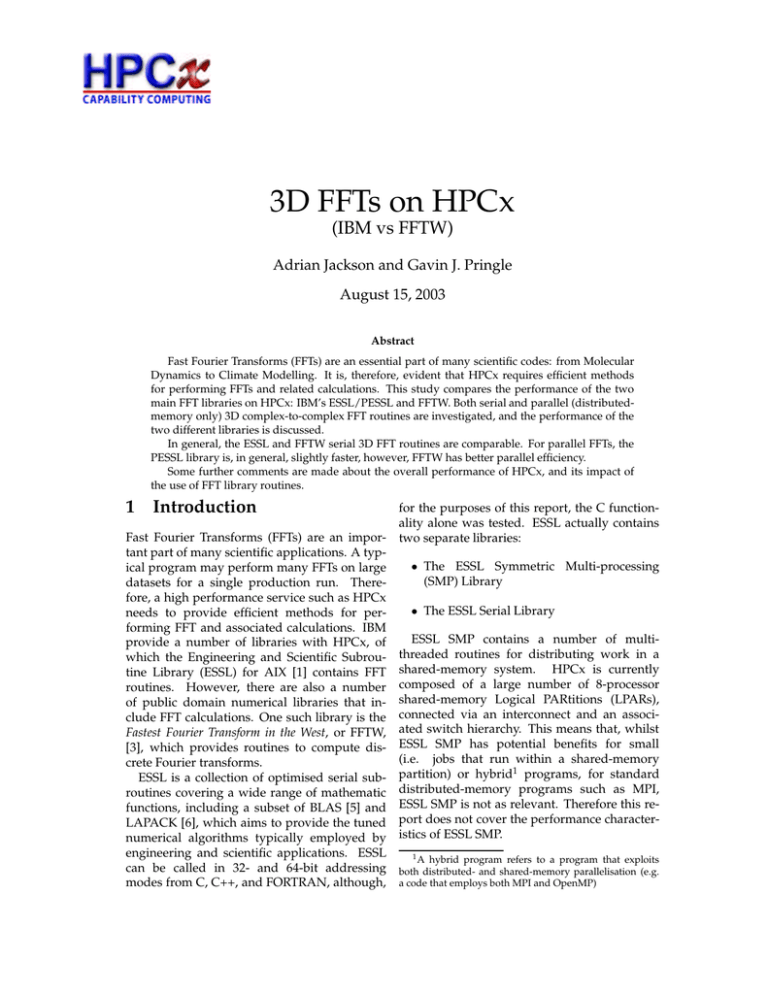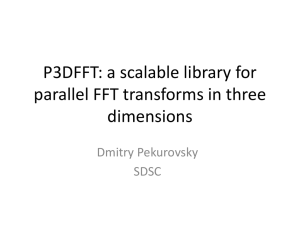3D FFTs on HPCx (IBM vs FFTW) August 15, 2003
advertisement

3D FFTs on HPCx (IBM vs FFTW) Adrian Jackson and Gavin J. Pringle August 15, 2003 Abstract Fast Fourier Transforms (FFTs) are an essential part of many scientific codes: from Molecular Dynamics to Climate Modelling. It is, therefore, evident that HPCx requires efficient methods for performing FFTs and related calculations. This study compares the performance of the two main FFT libraries on HPCx: IBM’s ESSL/PESSL and FFTW. Both serial and parallel (distributedmemory only) 3D complex-to-complex FFT routines are investigated, and the performance of the two different libraries is discussed. In general, the ESSL and FFTW serial 3D FFT routines are comparable. For parallel FFTs, the PESSL library is, in general, slightly faster, however, FFTW has better parallel efficiency. Some further comments are made about the overall performance of HPCx, and its impact of the use of FFT library routines. 1 Introduction Fast Fourier Transforms (FFTs) are an important part of many scientific applications. A typical program may perform many FFTs on large datasets for a single production run. Therefore, a high performance service such as HPCx needs to provide efficient methods for performing FFT and associated calculations. IBM provide a number of libraries with HPCx, of which the Engineering and Scientific Subroutine Library (ESSL) for AIX [1] contains FFT routines. However, there are also a number of public domain numerical libraries that include FFT calculations. One such library is the Fastest Fourier Transform in the West, or FFTW, [3], which provides routines to compute discrete Fourier transforms. ESSL is a collection of optimised serial subroutines covering a wide range of mathematic functions, including a subset of BLAS [5] and LAPACK [6], which aims to provide the tuned numerical algorithms typically employed by engineering and scientific applications. ESSL can be called in 32- and 64-bit addressing modes from C, C++, and FORTRAN, although, for the purposes of this report, the C functionality alone was tested. ESSL actually contains two separate libraries: • The ESSL Symmetric Multi-processing (SMP) Library • The ESSL Serial Library ESSL SMP contains a number of multithreaded routines for distributing work in a shared-memory system. HPCx is currently composed of a large number of 8-processor shared-memory Logical PARtitions (LPARs), connected via an interconnect and an associated switch hierarchy. This means that, whilst ESSL SMP has potential benefits for small (i.e. jobs that run within a shared-memory partition) or hybrid1 programs, for standard distributed-memory programs such as MPI, ESSL SMP is not as relevant. Therefore this report does not cover the performance characteristics of ESSL SMP. 1 A hybrid program refers to a program that exploits both distributed- and shared-memory parallelisation (e.g. a code that employs both MPI and OpenMP) As the ESSL serial library only provides serial routines, and we are not considering using ESSL SMP, a method for performing parallel FFTs is necessary. The IBM library used for parallel FFTs is PESSL [2] (Parallel ESSL). Again, this has two versions, PESSL and PESSL SMP, and both are available for C, C++, and FORTRAN. However, the PESSL version of the library only contains 32-bit routines, so 64bit applications must use the PESSL SMP library. Readers must note that the name PESSL SMP is misleading in that it does not equate to a distributed ESSL SMP library. The PESSL SMP library is a purely distributed-memory library, and achieves parallelism through the IBM BLACS[4] (Basic Linear Algebra Communications Subprograms) library. Like ESSL and PESSL, FFTW has libraries for both serial and parallel calculations and is a self-tuning library2 , meaning that, although it hasn’t been designed specifically for HPCx, it should compare favourably to the targeted IBM libraries. On HPCx, FFTW can be called in 32and 64-bit addressing modes from C, C++, and FORTRAN, although, for the purposes of this re port, the C functionality alone was tested. FFTW has methods for both shared-memory and distributed-memory parallelisations, with the latter using MPI. For the reasons mentioned previously, the shared-memory routines are not benchmarked in this report. As well as being self-tuning, thus allowing it to be highly portable without degrading performance, it has been optimised for a large set of FFT sizes: sizes that can be factored into the primes 2, 3, 5, and 7, and multiples of 11 and 13. Otherwise it uses a slower, general-purpose, FFT routine. This compares favourable to ESSL, which can only perform transforms on matrices with sizes corresponding to the following formula: n = (2h )(3i )(5 j )(7k )(11m ) for n ≤ 37748736, where h = 1, 2, ..., 25, i = 0, 1, 2, and j, k, m = 0, 1. In the case when ESSL cannot compute the FFT for the specified size, the matrix is generalised to the next largest size that ESSL can compute the FFT for. The FFT routines benchmarked in this report were 3D complex-to-complex. Note that both libraries limit the parallel data decomposition to one-dimensional, or slab, decompositions only. 2 In this situation, self-tuning refers to an adaptive software approach where the library tunes the way it performs FFTs to the specific hardware architecture of the machine it is compile on (see [7] for more details) For a benchmark written in C this translates to only the first dimension being decomposed, meaning a 1283 matrix distributed over 4 processors would give individual local matrices of 32 × 128 × 128. 1.1 Serial Performance For large arrays the IBM ESSL routines produce a slightly better performance than the FFTW routines. However, for small matrices the reverse is true: FFTW routines outperform ESSL. It is also interesting to note that the performance of the forward and backward transformations (i.e. is almost identical for FFTW, whereas the ESSL routines have difference performance characteristics with ESSL forward FFTs performing very poorly for small data size. 2 Parallel Performance The main area of importance for HPCx, and the main focus of this work, is parallel performance. Some HPCx users will construct their own parallel multi-dimensional FFTs using the serial FFT routines of FFTW and ESSL, however, other users may use the parallel FFT libraries of FFTW and PESSL. PESSL uses IBM’s BLACS[4] (Basic Linear Algebra Communications Subprograms) to perform data transforms, whereas FFTW uses MPI. Both libraries can only decompose data in one dimension. As the benchmarking code is written in C, this means it is the 1st dimension of the arrays that are decomposed. 2.1 Results The parallel routines were tested using 3 data sets, 1283 , 2563, and 5123. For the smallest data set (1283) PESSL and FFTW have comparable performance, with PESSL showing super linear speed-up for 4 processors, however, both libraries exhibit poor efficiency for more than 8 processors. This is because the dataset is not large enough to effectively use large number of processors. The results also highlight the difference in performance encountered when using processors in more than one LPAR. Whilst the speedup is good up to 8 processors (within one LPAR), once the program is tested across LPARs then there is a significant drop in performance. This highlights the fact that the performance of this code is dominated by communication, with good performance when using the fast shared-memory communication within a single LPAR but poor performance when communication is performed by sending messages across the network, between LPARs. The time to solution performance of PESSL and FFTW is also worth noting, with PESSL generally computing FFTs quicker than FFTW although both libraries have comparable times. As with the speedup results, FFTW performs considerably quicker for large numbers of processors. The middle data set (2563) shows a more pronounced difference compared with the previous scaling findings, with FFTW showing considerably better scaling than PESSL, although both libraries exhibit poor scaling. Because of the hardware memory limit on HPCx, the smallest number of processors this data set could be calculated upon was 4, therefore, all speed-up values have be calculated using the 4 processor results. As with the previous data set, PESSL performs quicker FFT calculations than FFTW for small numbers of processors, with the reverse being true when larger numbers of processors are used. There is also a less pronounced performance difference between jobs that are within one LPAR and those that span LPARs. This is a characteristic of the larger data set, which can make more efficient use of larger numbers of processors. However, even the larger data set does not mask the performance difference between communications within an LPAR and those across the switch. For the largest data set tested (5123), FFTW exhibits good scaling throughout the range of processors (see figure 1), showing near perfect speedup for 256 processors, and superlinear speedup for 64 processors. It is a large data set and is, therefore, able to efficiently exploit large numbers of processors. However, the performance still degrades when moving from 256 to 512 processors. This is probably because even this data set isn’t large enough to be able to efficiently use 512 processors. The size of the data set means that it cannot be tested on less than 32 processors (due to memory restrictions), so as with the previous benchmarks, the results have been scaled with reference to the results from the smallest number of processors. The forward and backward PESSL routines have similar speed-up curves. The timing data from the forward and backward FFT routines, for both FFTW and PESSL, are also very similar, with the backward FFT performing the calculation slightly quicker in both cases. For this data set, PESSL is consistently quicker than FFTW. 3 Summary For serial programs the choice of ESSL or FFTW will not seriously effect your performance, as both giving similar performance, with FFTW showing slightly better performance for small matrices and ESSL shows slightly better performance for larger matrices. Regarding parallel performance, PESSL is usually better, being, generally slightly faster than FFTW. For scaling, however, FFTW is significantly better than PESSL, especially for large processor numbers. Also, it must be noted that FFTW is much more portable than PESSL, so the choice of library must depend on the specifics of each individual code. Finally, both libraries lack the facility to decompose data in more than one-dimension, however, such a decomposition can be built by the user out of the serial FFT routines. 3.1 Future Work Both FFTW and PESSL can be further optimised and modified using various library options (i.e. strided ESSL/FFTW, IP(1)=0/FFTW TRANSPOSED ORDER, etc), alternative compiler flags (i.e. fast, -O5, etc) and system variables (i.e. MP EAGER LIMIT, MP POLLING INTERVAL, etc). Further work is needed to investigate whether the performance of these libraries can be improved, both in terms of computation time and scaling. Methods for optimising both libraries are discussed in their associated documentation. Benchmarking FFTW using an optimised MPI implementation may improve the performance of FFTW parallel FFTs. Also, if we use fewer processors per LPAR, then the parallel FFTs may give better scaling for both libraries. The performance of the libraries using very large numbers of processors (> 512) and very large data sets also need to be further investigated. Also, it would be beneficial to bench- Speedup 100 Ideal Speedup Forward FFT (PESSL) Backward FFT (PESSL) Forward FFT (FFTW Estimated Plans) Backward FFT (FFTW Estimated Plans) 100 Number of Processors Figure 1: Speed-up using a global matrix of size 5123 mark other libraries that perform FFTs, especially if they allow data to be decomposed over more that one dimension. Often, parallel FFTs are computed using serial FFT libraries and performing the necessary communication within the calling program (i.e. manually performing a number of serial FFTs and swapping data between processors). It would be interesting to benchmark FFTW and ESSL when used in this style and compare the performance to PESSL and the parallel routines given by FFTW. Finally, it maybe of interest to compare the performance of the underlying communication libraries, namely MPI vs BLACS. References [1] ESSL for AIX: Guide and Reference, Version 3.0, IBM Document Number: SA22-7272-04 [2] Parallel ESSL for AIX Guide and Reference, Version 2.0, IBM Document Number: SA22-7273-04 [3] FFTW Manual for Version 2.1.4, Frigo, M., Johnson, S. G., http://www.fftw.org/fftw2 doc/, March 2003. [4] A User’s Guide to the BLACS, Dongarra, J. J., van de Geijn, R. A., Whaley, R. C., Oak Ridge National Laboratory, Oak Ridge, Tennessee, June 1994. [5] Basic Linear Algebra Subprograms: A Quick Reference Guide, Dongarra, J. J., et al., University of Tennessee, Oak Ridge National Laboratory, Numerical Algorithms Group Ltd, May 1997. [6] LAPACK Users’ Guide, Anderson, E., Bai, Z., Bischof, C., Blackford, S., Demmel, J., Dongarra, J., Du Croz, J., Greenbaum, A., Hammarling, S., McKenney, A., Sorensen D., Third Edition, SIAM, Philadelphia, August 1999. [7] FFTW: An Adaptive Software Architecture for the FFT, Frigo, M., Johnson, S. G., http://www.fftw.org/fftw-paper-icassp.pdf.

